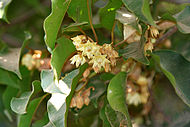| This article needs additional citations for verification. Please help improve this article by adding citations to reliable sources. Unsourced material may be challenged and removed. Find sources: "Mimusops elengi" – news · newspapers · books · scholar · JSTOR (October 2019) (Learn how and when to remove this message) |
| Mimusops elengi | |
|---|---|

| |
| Conservation status | |
 Least Concern (IUCN 3.1) | |
| Scientific classification | |
| Kingdom: | Plantae |
| Clade: | Tracheophytes |
| Clade: | Angiosperms |
| Clade: | Eudicots |
| Clade: | Asterids |
| Order: | Ericales |
| Family: | Sapotaceae |
| Genus: | Mimusops |
| Species: | M. elengi |
| Binomial name | |
| Mimusops elengi L. | |

Mimusops elengi is a medium-sized evergreen tree found in tropical forests in South Asia, Southeast Asia and northern Australia. English common names include Spanish cherry, medlar, and bullet wood. Its timber is valuable, the fruit is edible, and it is used in traditional medicine. As the trees give thick shade and flowers emit fragrance, it is a prized collection of gardens. It is used as an ornamental tree in many places. The flowers may also be used in natural perfume.
Its flower is the provincial flower of Yala Province, Thailand, as well as the city flower of Ampang Jaya, Selangor, Malaysia.
Tree description
| This section does not cite any sources. Please help improve this section by adding citations to reliable sources. Unsourced material may be challenged and removed. (July 2024) (Learn how and when to remove this message) |




Bullet wood is an evergreen tree reaching a height of about 16 m (52 ft). It flowers in April, and fruiting occurs between June and October. The leaves are glossy, dark green, oval-shaped, 5–14 cm (2.0–5.5 in) long, and 2.5–6 cm (0.98–2.36 in) wide. The flowers are cream, hairy, and scented. The fruits are fleshy, range in color between yellow and brown, and contain a large brown seed. The pulp has a yellow color and it is edible. The bark of the tree is thick and appears dark brownish black or grayish black in colour, with striations and a few cracks on the surface. The tree may reach up to a height of 9–18 m (30–59 ft) with about 1 m (3 ft 3 in) in circumference.
The seeds are just like the seeds of custard apple. About 1 to 1.5 cm in length and have a brownish black hard coat. They are quite easy to germinate. The process of soaking is helpful in speeding up the germination process. The trees like full sun. They grow with a moderate pace.
Distribution
The plant is native to South and Southeast Asia, particularly the coastal areas of the Indian subcontinent, Vietnam and Myanmar, as well as Northern Australia. It was introduced in China in the 20th century, and is now cultivated in its south, as well as in Taiwan.
Other uses
- The flowers are sun dried and used to make floral infusions and as an addition to green tea in Thailand.
- The edible fruit is softly hairy becoming smooth, ovoid, bright red-orange when ripe.
- The wood is a luxurious wood that is extremely hard, strong and tough, and rich deep red in color. The heartwood is sharply defined from the sapwood. It works easily and takes a beautiful polish. Density is 1008 kg per cubic meter.
References
- Barstow, M. (2019). "Mimusops elengi". IUCN Red List of Threatened Species. 2019: e.T61964765A61964768. doi:10.2305/IUCN.UK.2019-1.RLTS.T61964765A61964768.en. Retrieved 19 November 2021.
- ^ Bailey, L.H.; Bailey, E.Z.; the staff of the Liberty Hyde Bailey Hortorium. 1976. Hortus third: A concise dictionary of plants cultivated in the United States and Canada. Macmillan, New York.
- "Mimusops elengi". Biodiversity It is known as bakul in India. Retrieved 14 October 2013.
- "Maulsari". flowersofindia.com. Retrieved 14 October 2013.
- "ประวัติ จังหวัด ยะลา-Yala Province". Archived from the original on 2013-11-09. Retrieved 2013-03-25.
- "BUNGA RASMI MPAJ". Portal Rasmi MAJLIS PERBANDARAN AMPANG JAYA. 12 August 2015. Retrieved 15 November 2019.
- "Mimusops elengi L. | Plants of the World Online | Kew Science". Plants of the World Online. Retrieved 2022-02-07.
- 中国热带主要外来树种. ISBN 9787541654701.
Further reading
- Brock, J., Top End Native Plants, 1988. ISBN 0-7316-0859-3
| Taxon identifiers | |
|---|---|
| Mimusops elengi |
|
- IUCN Red List least concern species
- Mimusops
- Indomalayan realm flora
- Ericales of Australia
- Eudicots of Western Australia
- Flora of the Northern Territory
- Flora of Queensland
- Flora of tropical Asia
- Flora of New Caledonia
- Flora of Vanuatu
- Bushfood
- Plants described in 1753
- Taxa named by Carl Linnaeus
- Fruits originating in Asia